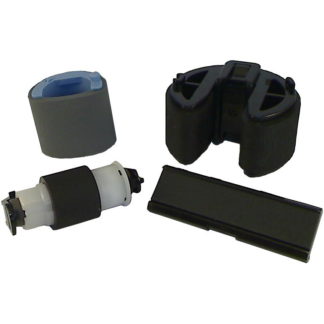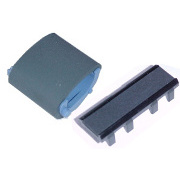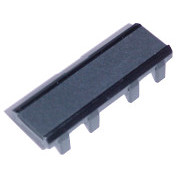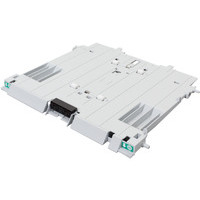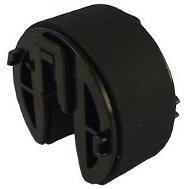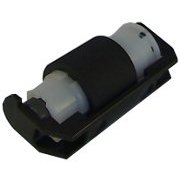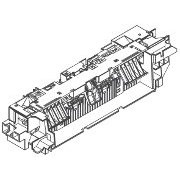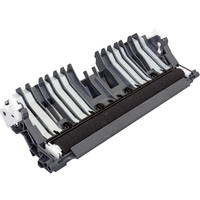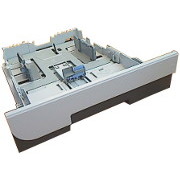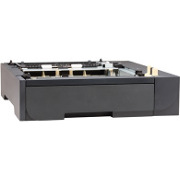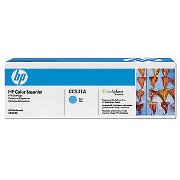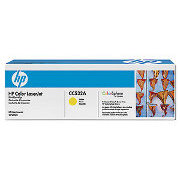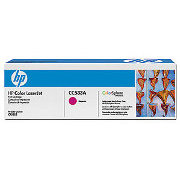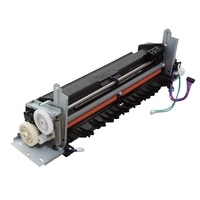HP Color LaserJet CP2025 Misfeeds and Cleaning

The most likely fix for misfeeds from the main paper cassette (Tray2) in the CP2025 & CM2320, is to replace the cassette pickup and retard rollers (FKITCP2025C). Fitting instructions can be found further down this page.
For more detailed discussion regarding other possible causes of misfeeds, read on...
The CP2025 has a reputation for paper misfeeds leading to frequently repeated cleaning cycles.
Google has clearly seen queries on this rather often - tens of thousands of entries. Amongst the prompts it offers are:
Excessive cleaning can be a problem with some colour printers, especially those that use an intermediate transfer belt and secondary transfer roller as in the CP2025. The printer relies on two things meeting correctly:
The printer makes up an image by running the belt under the set of four print catridges, each produces an image on its drum and as that passes over the belt surface it is transfered. As the belt moves it accumulates the complete image and as it gets to the secondary transfer roller position the image transfers to the page.
The image has already begun building on the belt as the printer starts attempting to move the paper. Suppose the paper rollers are worn, or the paper is a bit sticky for some reason, it won't arrive at the secondary transfer station in time. So the printer is now left with a belt-load of toner that has nowhere to go.
Anything that could leave the belt or transfer roller contaminated might spoil subsequent prints, so the printer prevents this by going into a cleaning cycle. This takes it a couple of rotations of the belt and several of the secondary transfer roller with voltages set to repel toner from the roller back onto the belt and off again into the waste disposal mechanism.
The designers might have tried to ensure paper would feed before starting the image, but that would make the printer quite a lot slower. Older HP Printers (the 2600 / 3600 / 4600 series) did not have this problem. The transfer belt had a rather different function and actually atached the paper to the belt and then transfered the toner to the paper. A misfeed would be detected before printing started. Doing things this way might have meant image quality was a bit lower.
Why Paper Misfeeds
Cut sheet paper feed does not look massively complicated. But it took nearly a century of slightly dodgy inventions by the typewriter and printer industries to get something reasonably reliable.
There is a soft rubber pickup and drive roller to push the paper and a drag-roller rather than a pad to give separation. The separation roller is a bit of an innovation. HP tended to use either a pad or a counter-rotating torque roller in the past and were presumably aiming at something longer lasting and more reliable. Not every idea works correctly - and it does seem to be the pickup roller that gives the problem.
However we can look at every other possibility.
Paper Size Issues
Printers do inevitably misfeed for all sorts of reasons. Paper quality issues such as binding at guillotined edges, damp paper (often it curls excessively) or unusual gloss finishes are a cause. Things like labels can also get caught in the print path and sometimes cause intermittent misfeeds.⇓
Paper size settings are often to blame. Colour laser printers may need a cleaning cycle if they are given an incorrect paper size and type. Paper sizes and types are typically given in the following places:
- Application software - such as Word or Excel
- Printer driver in the computer - accessed via Control Panel
- Any tray applet in the computer
- The printer itself via its control panel or embedded web server.
Settings often are wrong when a printer is newly installed. This is particularly likely in the UK. The default US settings on computers seem to work because the language is right but the paper size is wrong - we use A4 standard paper and the Americans use US-letter. (Settings on a laser printer itself are likely to be right because the fuser is 220 volt so the factory is likely to have pre-programmed that. Inkjet page settings are more likely to be wrong.)
There are several places where printer page settings might be set, finding a wrong setting can seem a bit of a chase.
Application settings will usually override all others; some applications like Microsoft Word will have them under a title such as document properties. Whether an application has any print settings and the settings it has depend to some extent on its author and on how it interacts with the print-driver on the local computer.
The main print settings are the print driver on the local PC. There should be settings for almost every feature the printer has including paper sizes and paper type. With Microsoft Windows many of the settings are available when print is selected in the menu, and the same is generally true of Linux. There could be more in the printer settings section of control Panel
. In cases where the PC is part of a network the print-driver may be controlled by the IT department.
HP used to supply a task tray applet ToolboxFX
for Windows which provides configuration, status and support for every feature
and checks the device status, configures settings, sets up automatic alerts, orders supplies online, views self-help information and offers troubleshooting tips
.
HP seem not to have updated ToolboxFX for Windows 7, much to many users annoyance. Linux users never did have it, but much the same information can be seen by going to the printers internal web server. Get the printer's IP address from a configuration page; open a browser and put the IP address in the address bar. (The printer's embedded website works for Windows as well)
The printer itself may also have settings. Printers that have a control panel with an LCD display almost certainly will have a comprehensive list of local settings. Many of these settings within the printer are normally overridden when a job is sent by the computer. The printer settings are primarily there to act as defaults for situations where the computer does not send settings - for instance copying to /dev/lpt
in Unix. Although the printer settings are usually overridden by those from the computer print driver there are occasions when that doesn't happen and it will usually be best to have them set correctly if they are present.
Printers with no control panel and only a direct USB connection to the PC may belong to the Winprinter
class of devices. In these cases the printer gets a pre-rasterized image from the computer and may have no internal settings of its own.
The CP2025 is an intelligent device with both PCL-5 and PCL-6 language capabilities and a PostScript 3 emulation. As well as the front control panel there is an internal embedded web-server which can be accessed through a browser. HP also provide Easy Printer Care
(EPC) and HP WebJet Admin. In other words, it will help to make sure the paper sizes are set correctly throughout, it removes doubt. Also, if the sizes aren't right help-desks will tend to focus on this first.
CP2025 Specific Problems
The problem in the CP2025's case is that cleaning cycles are being triggered more often than with other printers. Far more than users expect - and at some cost in waste paper and toner.
The fault seems to relate to wear on the tray 2 pickup roller RM1-4426. The roller is quite substantial, but after some use of the printer it may lose its ability to deliver paper at the right time or with no skew to the registration roller. Paper may not actually seem to misfeed in that there is no paper left in the print path, but the printer thought
some print had missed the page, hence the cleaning.
Before the paper arrives at registration the printer has built the image to transfer on the intermediate transfer belt (ITB). Because of the apparent misfeed, that now can't be used and there might be toner contamination of the belt or transfer roller. The printer goes into cleaning mode in preparation for a new image on the ITB. The user is notified next, - it says Misprint
and waits for the user to press OK
, then the page that failed is reprinted.
Pages might be misprinted, if the first printing was near the top margin it may be missing. Quite often there may seem to be no misprint at all, there is just the annoying need to repeatedly press OK
and get a duplicate page.
The fault is often more noticeable with long documents and where the auto-duplex (double sided print) is in use. In these cases one page follows another quickly and precise timing is more likely to be an issue.
Fault Elimination
It is possible to reduce or eliminate the fault by setting Tray 2 paper type to Heavy - 111-130g
. Using the heavy paper setting does slow the printer down. HP forum entries recommend changing the setting in ToolboxFX
or EWS
(but there is no Toolbox FX for Windows 7, it seems you must use HP Easy Printer Care instead - but that won't work with USB).
The problem should go away if the fold-down tray 1 is used. This helps indicate that the fault really is the tray 2 pickup roller rather than some other issue. It is important to eliminate other issues. All printers get paper misfeeds from time to time and it is better to confirm the fault rather than just assume that any misfeed must share the same cause as those found on web forums. Users may not like having paper in a fold-down tray because it doesn't look neat and they may want separate trays for envelopes, letterhead and white paper but it is best to eliminate other possible causes of a problem.
The fault may not be present with tray 3 if the printer has one (it's an optional accessory).
Once the fault occurs it can be persistent and annoying. However the fault can also be erratic so that apparent cures might be found by turning the paper over, using different cartridges, changing the drivers, upgrading the firmware, printing from a different PC and so forth. All these explanations are found in various forums. Short print jobs of 1 or 2 pages may not trigger the fault, it seems to be the timing of page 3 or 4 that causes it.
The actual fault is probably not the roller, which is also used in other printers such as the CP1215/1515/1518/ and CM1312/2320. It seems likely to be sensors, firmware or timing.
The fault has been reported under Windows XP and Windows 7, both 32 bit and 64 bit drivers. It is also seen with Apple OS X and Linux, so there does seem to be a fault that is with the printer - not the drivers.
If the printer is shared between PCs and the fault does always occur with one but not another then that has to be a strong indication that it relates to print driver settings on that PC - probably paper size.
Fault Finding and Fixing:
Try printing from the multi-purpose tray 1 and from tray 3 if it is present.
Check the application and driver settings which should probably be A4 in the UK and Europe, and letter in the US. (see above)
- Check the paper size settings in the the application (Page Setup in Word, Excel etc)
- Check the paper size settings in the the print driver - the settings in the print dialog
- Check the settings in ToolboxFX (the applet in the task tray. Changing to the
heavy paper
setting may help) - Check the settings on the printer itself
- Check the printer error log for size errors and misprints.
Settings from the application generally override the driver, and the driver overrides the settings of the printer control panel. Some drivers (Linux for example) might not apply every possible override. If the printer is told to expect the wrong size of paper then it may well sometimes work - this is common to a lot of printers, they do their best with the information they are given.
Clear Permanent Storage
HP tech support have suggested in forums that there may be an issue with something in the printer's permanent storage, (they have not suggested what the issue might be) so erasing the storage may improve matters
- Turn the printer off.
- Whilst the printer is off press and hold both right-arrow (>) and cancel (x).
- Turn the printer on with the buttons still pressed.
- After a while the message
Permanent Storage init
appears - release the buttons.
Restore Factory Defaults
Another possibility is to restore factory defaults:
- Turn the printer off.
- Go to the
SERVICE
Menu andRESTORE DEFAULTS
- Push OK
Experience on forums seems to have been that despite a RESTORE DEFAULTS operation the fault will probably recur after several hundred pages.
Update the Firmware
Most modern equipment stores its program in a memory that can be re-written, often a flash memory chip. Instructions on one of the communications interfaces can be used to overwrite the existing program. Manufacturers often go on developing software whilst a product is in production, possibly adding features that competitors have or removing problems.
Newer versions of the firmware for the CP2025 are said to be less prone to the fault
Many printers shipped with Firmware Datecode: 20081218 - Use Datecode: 20100512 or later. Latest appears to be 20140702, issued Aug 2014.
We haven't as yet found anything claiming that a firmware update eliminates the problem (although we received an email in July 2018 from someone who said that after installing new firmware, the drawer 1 and 2 errors stopped).
Replace CP2025 Rollers
Replacement paperfeed roller kits are available here: ![]()
If all else fails, or if you can see no reason why the printer should have started to behave differently, then replace the tray 2 pickup roller (RM1-4426) and the separation roller (RM1-4840). The job is fairly easy.
- The printer needs to be put into the secondary service menu:
- Press and hold left-arrow (<). The display will continue to cycle through setup menus.
- Press Cancel (x) once, then release the left-arrow (<). Now an additional "2ndary Service" menu will appear in the cycle.
- With "2ndary Service" showing (use left/right arrows if necessary), press OK.
- Press left-arrow (<) once so that the display shows "Pick roller", then press OK.
- Press OK again to confirm the roller is to rotate.
- Listen for the roller to rotate.
- Unplug the printer, then put the power switch into the off position.
- Remove cassette tray 2 so that the rollers can be seen.
For the copier version of the CP2025, the LaserJet CM2320, the above sequence needs two extra steps:
- 1a. Press Setup (spanner) to enter the main menus.
- 3a. Press Setup (spanner) to return to the main menus.
Tray 2 roller and separation roller changing goes as follows:
- Lift the printer by the sides of the tray recess so that the roller can be seen more easily (however do not tip the printer right over as toner might fall into the scanner optics).
- The tray 2 pickup roller has white locking tabs at either side, push them outwards (they are quite tight) to release the roller. Lift it out.
- Remove the separation roller cover and lift it out.
- Replace the separation roller and its cover.
- Replace the pickup roller, handle it by the sides, not the rubber, as grease from fingers can degrade the rubber material.
Tray 1 rollers normally wear less than tray 2 because the tray is used less, however replacing both is often convenient because it removes doubt.
- Lower the tray 1 paper pickup assembly by pushing down on its edges.
- Release the tabs at either side and rotate the roller slightly to remove it from the printer.
- The Tray 1 pad and holder unclips - be careful not to lose the spring.
- The old pad can be prised from the holder using a 6mm flat blade screwdriver (it is just tight, not glued).
- Replace the pad and then the roller.
Details of roller and pad replacement are given from page 104 onwards of the service manual.
Replace Paper Feed Stepper Motor
If replacing the cassette pickup and retard rollers does not eliminate the misfeeds, the paper feed stepper motor ( RM1-5419) may need replacing.
Another Possibility
[Added May 2018] One of our site visitors (thanks Nigel) has reported having had some success by removing the spring within the separation roller. This might result in jams caused by 2 sheets feeding together, but it's worth a go if the usual roller replacement fails to prevent misfeeds.
Links
Cleaning-at-every-possible-moment
Sites that want money for the answer:
HP ToolboxFX Information
We did have some information on ToolboxFX at this link - but HP are always reorganising their site and breaking links. ToolboxFX
Copyright G & J Huskinson & MindMachine Associates Ltd 2013, 2015. Some pictures derived from HP User and Service guides. These technical pages do not constitute an offer for sale; just our knowledge at the time of writing. See the catalog. Sales pages on this Web site use cookies to store user information. We also use Google Analytics to track site usage patterns.

